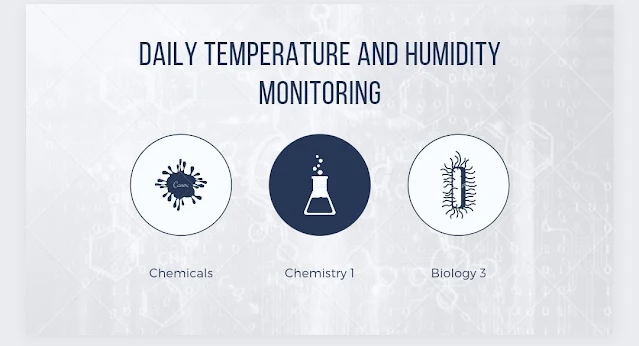This document details the procedure for the Daily Temperature and Humidity Monitoring. It is the policy of XYZ Limited that a written procedure shall be followed for Daily Temperature and Humidity Monitoring. The purpose of this procedure is to ensure that all types of materials are stored in suitable storage conditions to prevent deterioration of contents and compliance with regulatory requirements.
{tocify} $title={Table of Contents}
This
procedure is applied during Daily Temperature and Humidity Monitoring.
RESPONSIBILITY
Persons
along with their responsibilities are given below:
Executive-
Corporate/Quality Assurance: - To prepare the SOP and follow the same
Trainee Analyst/ Jr. Analyst/ Analyst/ Sr. Analyst:- To
follow the SOP accordingly
Manager – Quality Assurance: - To ensure the implementation
of SOP
In charge-Warehouse: - To ensure implementation of SOP
5.0 Daily Temperature and Humidity Monitoring Procedure
5.0.1 ALL DRUGS AND DRUG PRODUCTS SHOULD BE STORED
ACCORDING TO THE CONDITIONS DESCRIBED ON THE LABEL. WHEN SPECIFIED ON THE
LABEL, CONTROLS FOR HUMIDITY, LIGHT, ETC. SHOULD BE IN PLACE.
5.02 For
Daily Temperature & Humidity monitoring Digital or Manual (Wet & Dry)
hygrometer can be used.
5.0.3 Temperature
should be controlled and monitored using calibrated monitoring devices (Digital
or Wet &Dry bulb hygrometer) and records of temperature should be
maintained. Monitoring is conducted at points representing the extremes
of temperature range based on Temperature mapping.
5.04
Fix the position of the device used for Daily Temperature & Humidity
monitoring.
5.0.5
Place the Wet &Dry bulb hygrometers in a position with a steady flow of air
around the mercury bulbs.
5.0.6 Fill
the cistern with Demineralised water to avoid the wick becoming clogged with
impurities. The wick should be changed regularly to ensure a constant flow of
moisture to the wet bulb.
5.0.7 Allow
the mercury columns to remain steady.
5.0.8 Take
the reading of the Wet and Dry bulb columns.
5.0.9 Subtract
the reading of the Wet-bulb column from that of a dry column, thus arriving at the depression value.
5.1.0
In the provided table, locate the dry bulb and the depression value given by the
hygrometer, and at the intersection of the two columns, read off the percentage
humidity.
5.1.1 The
following example illustrates the method of using the tables--
Reading of Dry bulb--------------------------------30˚C
Reading of Wet bulb -------------------------------25˚C
Hence the depression of the Wet Bulb--------30˚C- 23˚C = 7˚C
Reading directly from the tables, the relative humidity is 53%
5.1.2 Temperature
and Relative humidity monitoring shall be done twice a day i.e. morning
(9.00 to 10.00) and afternoon (16.00 to 17.00) by using a
Hygrometer.
5.1.3
In the case of a Digital Hygrometer take a reading of Temperature &
Humidity displayed on the screen.
5.1.4
The record of temperature and humidity shall be maintained on SOP Daily Temperature and Humidity Monitoring.
5.1.5 In the morning, check and record the current Temperature and Humidity from the hygrometer
(digital/Wet & Dry bulb)
5.1.6 In the afternoon, check and record the current Temperature and Humidity
from the hygrometer (digital/Wet &Dry bulb)
5.1.7 In case of an excursion, record and explain the excursion. Written procedures
should be available describing the actions to be taken in the event of
temperature excursions outside the labeled storage conditions.
5.1.8
If the excursion cannot be explained, inform to Maintenance and Quality Assurance
Manager for necessary action.
Acceptance
criteria (for building material section)
Temperature: 27±2°C
Humidity: 65±5%RH
5.2.1
The record of temperature and humidity of the Building
material section shall be maintained as per
Appendix II APL/CQA/SOP-032/FR-02
5.3 Acceptance
criteria
Temperature:
NMT 27°C
Humidity:-NMT
55%RH
Note: For a
normal product that is not highly sensitive to humidity it should be NMT
55%RH
but
in the case of specific products humidity shall be maintained as per
requirement.
Examples
of certain products for which Temperature &Humidity conditions are
maintained
Empty
Capsules Storage-----40-65%RH
Capsule
filling area& For Antibiotics ---------35-50%RH
Highly
sensitive items like
Cloxacillin
sodium ------25-35%RH
Clavulanate
Potassium----25-35%RH
Dry
place as per USP correspondence to about 45%RH
Ranitidine, Omeprazole, Lasnoprazole, --------------- 35±5%RH
Rabeprazole,
Pantoprazole, Ethambutol ----------------- 35±5%RH
5.4 ABBREVIATIONS
NMT:
Not more than
NLT:
Not less than
QA:
Quality Assurance
RH:
Relative Humidity
%
: Percentage
˚C: Degree Celsius

